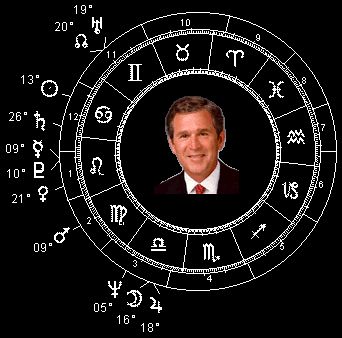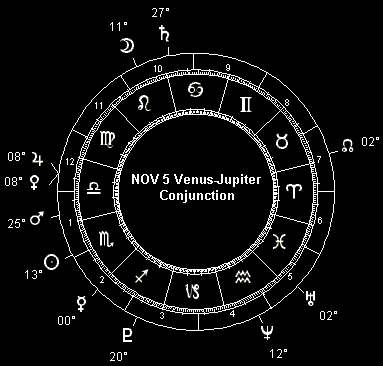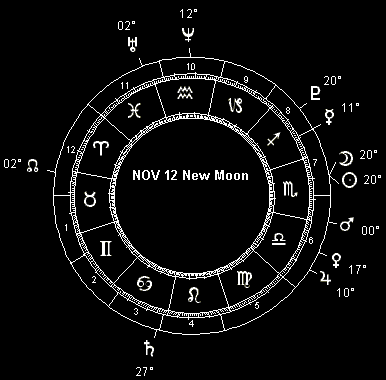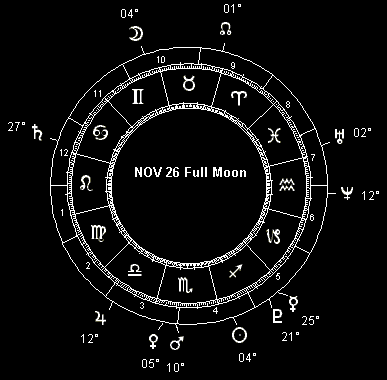If you were expecting some kind of sun sign nonsense, forget it. This is real astrology. See the section above. And if you need help deciphering the astrological glyphs in the graphics accompanying this article, see Astroglyphs: Astrological Symbols Guide. Please note: this forecast is expressed in terms of Universal Time (UT).
The trouble with our times
is that the future is not what it used to be.
-- Paul Valery
 The thing everyone wants to know about November is very far from celestial. It's as mundane and prosaic as an address; namely 1600 Pennsylvania Avenue, and who'll be the tenant there come January 20, 2005. Based on the best astrological data available to me last year, I summed up my read on the election in my 2004 World Forecast Highlights this way: "a toss-up . . . with the edge to Bush because the GOP chart presages the Republicans getting out their vote better." This, despite the fact that the astrological odds are stacked against President Bush in one very important respect, as I noted:
The thing everyone wants to know about November is very far from celestial. It's as mundane and prosaic as an address; namely 1600 Pennsylvania Avenue, and who'll be the tenant there come January 20, 2005. Based on the best astrological data available to me last year, I summed up my read on the election in my 2004 World Forecast Highlights this way: "a toss-up . . . with the edge to Bush because the GOP chart presages the Republicans getting out their vote better." This, despite the fact that the astrological odds are stacked against President Bush in one very important respect, as I noted:
"George W. Bush has so far stood for election four times in his life, and lost only once. That was his first time out, a run for Congress in 1978. It was the only time until 2004 that he went to the polls with transiting Saturn lined up right on one of his natal planets. In the 1978 election, transiting Saturn was less than three degrees from Bush's natal Mars. This time around, Saturn will be less than a degree from its place in his birth chart. All else being equal, unless he goes up against an opponent with equally dismal transits, the incumbent has less than even odds of winning reelection."
The key lies in the President's opponent. Senator Kerry's birth data were unknown to me last year when I wrote my forecast. The Senator is said to have given his birth time as 8:03 AM (on December 11, 1943 in Denver, CO). If true, his astrological chart does indeed get some favorable aspects on Election Day; most notably a Venus-Jupiter transit across the midheaven. In and of itself, that's about as close a lock on victory as there is.
However an even stronger transit is simultaneously in effect: Pluto across the Sun (opposed by Saturn natally), within two degrees of being exact. That's an ambiguous transit, suggesting a figurative death-rebirth scenario. It's a long-lasting transit too, having been in effect for Senator Kerry off and on since December 2001 - a period which coincides with his presidential campaign and his bout with prostate cancer. All else being equal, the simplest and most straightforward reading of Pluto's transit across the Sun and ascendant in anyone's chart is: an old way of life comes to an end, a sacrifice is required, and if life goes on it does so in a very different way. For a politician, how can this mean an election victory? I just can't see how it could.
 On the other hand, if you want to get really Virgo about it, the old way of life coming to an end for John Kerry the politician might be - instead of the end of a career in politics altogether - the end of one political career (in the legislative branch, as a Senator) and the beginning of a different political career (in the executive branch, as President). That just doesn't ring true to me, but I have to bring it up because it is a possibility.
On the other hand, if you want to get really Virgo about it, the old way of life coming to an end for John Kerry the politician might be - instead of the end of a career in politics altogether - the end of one political career (in the legislative branch, as a Senator) and the beginning of a different political career (in the executive branch, as President). That just doesn't ring true to me, but I have to bring it up because it is a possibility.
All things considered, including Senator Kerry's timed birth data, I can't think of a defensible alternative to my 2003 forecast of the 2004 US Presidential election: "a toss-up . . . with the edge to Bush because the GOP chart presages the Republicans getting out their vote better." Right or wrong, I'll stick with it and take my lumps if it comes to that. (As a registered and voting Libertarian, I have no partisan bias: the two major parties are Tweedledee and Tweedledum, as far as I'm concerned.) Meanwhile, seeing the forty years of ugly partisan alienation that has plagued the US pretty much ever since the Kennedy assassination, I hope this will be the last of the bitterly polarized elections we'll have to endure for a long, long time. And it just might be the last big nasty for many years, since this will be the last election to coincide with Pluto's transit to Uranus, the ascendant and Mars in the US Declaration of Independence chart - a combination that's been off and on within a few degrees since the Clinton impeachment.
Frankly, once the campaigning and ballot counting and legal wrangling is all done and behind us, I'm sure plenty of people will be glad to get back to a less politicized reality. There'll still be a certain contingent of extremist party hacks consumed with whining and moaning about how their guy was robbed, how the system is unfair, etc. I can only hope they'll shut up and go away and just annoy each other, and leave the rest of us alone.
Meanwhile, it seems only fitting to me that the US elections fall on the day of the Moon's most extreme declination north of the equator for all of 2004. This signals a brief upsurge in storm and seismic potential, including an elevated risk of bad weather that could hurt turnout in the Carolinas and the Midwest, plus Alaska and along the Pacific Northwest coast. Weather aside, this is also a time to watch the headlines - and take precautions, if you're going to be in a vulnerable locale - for moderate to severe earthquake activity (Richter 5 and up). Volcanic eruptions are part of this same potential, which is in effect from the 1st through late on the 2nd. (This is a worldwide phenomenon. I mentioned the most vulnerable looking US locations only in connection with the possible effect on voter turnout.)
 There's a lot more to November than the US elections in any case. A beautiful morning star Venus-Jupiter conjunction on the 5th is one factor presaging a general up-trend in major equity markets. This looks like more than just a temporary blip, what with Saturn's retrograde station on the 8th. I see this as a sign of a general (though not raging) bull market trend through the end of the year. Since Saturn has been within a degree of its 27 Cancer station since around October 10, chances are good that this little year-end bull run has already started. It'll have its upsets here and there, particularly toward the end of the month. But it beats the over-all September-October trend handily.
There's a lot more to November than the US elections in any case. A beautiful morning star Venus-Jupiter conjunction on the 5th is one factor presaging a general up-trend in major equity markets. This looks like more than just a temporary blip, what with Saturn's retrograde station on the 8th. I see this as a sign of a general (though not raging) bull market trend through the end of the year. Since Saturn has been within a degree of its 27 Cancer station since around October 10, chances are good that this little year-end bull run has already started. It'll have its upsets here and there, particularly toward the end of the month. But it beats the over-all September-October trend handily.
That's not to say that November is a month of milk and honey. Look for terror atrocities around the time of the Mars-Saturn square on the 7th and the Mars-Neptune square on the 30th, give or take a few days in each case. This is a time fraught with the potential for violence and accidents, a good time to be especially safety-conscious. Likewise the Uranus station on the 11th raises the potential for shipping accidents, oil shocks, chemical messes and disease outbreaks. Unfortunately, as Uranus remains within a degree of its station point all month, the period around the 11th is only a peak in this potential, which remains in effect throughout November. This same period is part of the geophysical turbulence associated with the southward lunar declination crossing on the 9th, the new moon at 21 Scorpio on the 12th, the lunar perigee (closest approach to Earth) on the 14th, and the south lunar declination extreme on the 15th. All in all, it's a stretch of elevated storm and seismic risk that stretches from late on the 7th into early on the 17th. Be prepared for stormy weather, and have your emergency plans ready if you live in an earthquake-prone area. If traveling, be sure to allow extra time for weather delays. As always, because they're planetary in scale, these geocosmic shock windows are planet-wide in scope: no place on Earth is totally beyond their reach. Still, zones of possible extra vulnerability include the eastern coastline and central part of South America, the central longitude of Greenland, the easternmost tip of Canada, and a north-south swatch from Shanghai to Tokyo and downwards through Indonesia and Australia.
 November 21, when Mercury reaches its maximum elongation east of the Sun, marks the beginning of the little planet's intersolar period, which carries through to Mercury's December 29 maximum western elongation. This includes, of course, the entire Mercury retrograde period (November 30 - December 20), when the sun-grazer appears to move backwards through the heavens as seen from Earth. All things Mercurial are a focus of what this intersolar period is all about: commerce, communication, education, infrastructure (including all manner of networks, from roads and canals to the power grid to the Internet). Being on the same side of the Sun as Earth during this period, Mercury and all it signifies will become more important than usual, more crucial and more urgent somehow. That would be fine, were it not for the normal human tendency to screw things up through inattention - which is the very last thing you want whenever Mercurial reality is key.
November 21, when Mercury reaches its maximum elongation east of the Sun, marks the beginning of the little planet's intersolar period, which carries through to Mercury's December 29 maximum western elongation. This includes, of course, the entire Mercury retrograde period (November 30 - December 20), when the sun-grazer appears to move backwards through the heavens as seen from Earth. All things Mercurial are a focus of what this intersolar period is all about: commerce, communication, education, infrastructure (including all manner of networks, from roads and canals to the power grid to the Internet). Being on the same side of the Sun as Earth during this period, Mercury and all it signifies will become more important than usual, more crucial and more urgent somehow. That would be fine, were it not for the normal human tendency to screw things up through inattention - which is the very last thing you want whenever Mercurial reality is key.
Add it all up, and what you get is an abundance of snafus, a veritable festival of Murphy's Law run rampant. The solution? Take nothing for granted. Follow up on everything, assume nothing. Double-check everything, then triple-check it. Clarity, simplicity, redundancy and follow-through: that's what it takes, just to keep the whole thing from coming off the tracks. Even given all that, you'll still be surprised at how many ways things can go awry, how readily misunderstanding can arise. Do your best: it won't be enough in every instance, but it's all you've got. Lost messages, crossed wires, phone outages, computer breakdowns, hacker attacks, power failures, missing luggage and packages, traffic delays, faulty assumptions and misunderstandings aplenty: it's all par for the course during Mercury's November 21 - December 29 intersolar phase.
 You watch, you'll see the comedy of errors cranking up starting on November 21, as Mercury reaches its easternmost extreme from the Sun. By the time the little planet turns retrograde on November 30, it's not funny anymore. Around December 10, when Mercury's aligns in inferior conjunction with the Sun, the magnitude of the problem has become enormous enough that even those who aren't paying attention start figuring it out. By December 20, the day Mercury's retrograde ends, the signal to noise ratio is getting close to normal again. And by the time Mercury reaches its westernmost extreme on December 29, humanity returns to its normal automatic pilot, sleepwalking state. These key points in the cycle aside, other critical junctures come around November 21 and December 7 (Mercury conjunct Pluto).
You watch, you'll see the comedy of errors cranking up starting on November 21, as Mercury reaches its easternmost extreme from the Sun. By the time the little planet turns retrograde on November 30, it's not funny anymore. Around December 10, when Mercury's aligns in inferior conjunction with the Sun, the magnitude of the problem has become enormous enough that even those who aren't paying attention start figuring it out. By December 20, the day Mercury's retrograde ends, the signal to noise ratio is getting close to normal again. And by the time Mercury reaches its westernmost extreme on December 29, humanity returns to its normal automatic pilot, sleepwalking state. These key points in the cycle aside, other critical junctures come around November 21 and December 7 (Mercury conjunct Pluto).
The plus side of intersolar Mercury - yes, there is one - is that it's a time of mysteries solved and problems fixed, by people who don't take things at face value. If you're willing to furrow your brow, focus your gaze and apply yourself, then this is a good time to take inventory, get to the bottom of things, find what's lost and fix up messes. Heaven knows, there's plenty of material to work with, at times like this.
November ends on a turbulent note, geophysically speaking. An upsurge in storm and seismic potential is due from late on the 20th through the 30th, associated with the Moon's northward crossing of the celestial equator on the 22nd, the full Moon at 5 Gemini on the 26th, and the north lunar declination extreme on the 29th. Strong storms with high wind and heavy precipitation are par for the course at times like this, along with moderate to severe seismic activity (Richter 5+ earthquakes and volcanic eruptions). Have fresh water and batteries ready just in case, and check the stock of canned goods and such: no sense getting caught unprepared. If you're traveling during this period, or expecting someone who is, be sure to allow for weather-related delays.
 SPECIAL FEATURE: This month's birthdays of the famous and infamous (with astrological birth charts)
SPECIAL FEATURE: This month's birthdays of the famous and infamous (with astrological birth charts)
